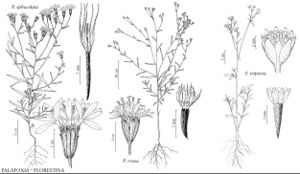Florestina
Bull. Sci. Soc. Philom. Paris 1817: 11. 1817.
| Taxon | Illustrator ⠉ | |
|---|---|---|
 | Palafoxia sphacelata Palafoxia rosea Florestina tripteris | Linda Ann Vorobik Linda Ann Vorobik Barbara Alongi |
Annuals [perennials], 10–60 cm. Stems erect, branched (mostly distally). Leaves cauline; opposite (proximal) or alternate (mostly); mostly petiolate; blades (3-nerved or 5-nerved) simple (proximal and distal) or (midcauline) 3-lobed or 5-lobed or foliolate; blades or leaflets broadly to narrowly oblong to ovate, ultimate margins entire, faces sparsely to moderately scabrous (hairs white, antrorse, 0.3–0.7 mm), usually glanddotted as well. Heads discoid, in ± corymbiform to paniculiform arrays. Involucres obconic to subhemispheric, 3–6+ mm diam. Phyllaries falling, 4–14 in 1–2 series (obovate to oblanceolate, subequal, thin-herbaceous, margins scarious, sometimes purplish). Receptacles concave to convex, knobby or smooth (sometimes minutely setose or hairy), epaleate. Ray-florets 0. Disc-florets 10–30+, bisexual, fertile; corollas whitish, sparsely glandular-hairy, tubes longer than funnelform throats, lobes 5, lance-linear (often unequal). Cypselae obpyramidal, 4-angled, faces sometimes ribbed, sparsely hairy (hairs curled); pappi persistent, of 8–12 (distinct) spatulate to lanceolate [suborbiculate], medially thickened, laterally scarious scales in 1 series (some, all, or the alternate aristate). x = 12.
Distribution
Tex., Mexico, Central America
Discussion
Species 8 (1 in the flora).
Florestinas are closely related to, perhaps congeneric with, palafoxias.